Why Do Dog?
I love downward-facing dog. It turns my world around, immediately changing perspective about the challenging issues in life, calming the thinking brain, and over time in my asana (pose) practice, it feels quite comforting. You may love this pose in its classic form, or perhaps that form is not for you. That’s OK! Allow me introduce you to, or remind you of, the various ways adho mukha svanasana, downward dog ; (“adho(downward) mukha (face) svanasana (svana=dog)” can take shape in your physical body, receiving its benefits.
Some general benefits* of Downward Dog
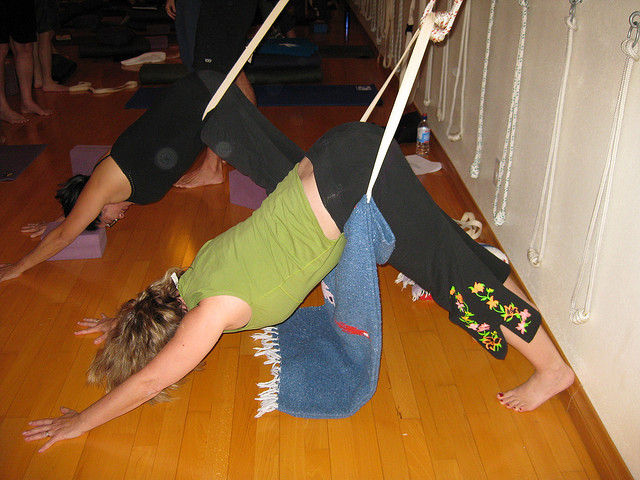
-Strengthens the arms. In doing so can help prepare you for arm balances such as handstand.
-Can increase shoulder joint mobility.
-Can free restrictions around the diaphragm for better breathing.
-Helps traction the spine, allowing more space between the vertebrae.
-Brings flexibility to the back legs and bottom of feet and toes
–Facilitates calm, down-regulating anxiety and worry
– Stimulates the posterior vertebral bodies and joints of the spine, pelvis and arms (Yoga for Osteoporosis, Loren Fishman, MD and Ellen Saltonstall, RYT 2010)
-Engages all three bandhas (locks or seals), stimulating the energetic body or kundalini (Yoga: the Practice of Myth and Sacred Geometry, Rama Jyoti Vernon, 2014)
*With special thanks to my teachers Tias Little and Jill Miller for their multidimensional and deep approach to exploring the pose when I studied with each of them many times.
Cautions (particularly for the classic pose)
–Wrist issues such as carpal tunnel will call for modifications.
-Should not perform with untreated high blood pressure.
-The head down posture of downward dog is proven to increase eye pressure. Those with glaucoma should use caution and avoid the full pose.
-NOTE: I typically do not teach the full pose in group prenatal classes, particularly for women in the final trimester of pregnancy. As is evident, many modifications are available during this beautiful and temporary stage of a woman’s life.
Ways to Practice
Here is a tour of the many breeds of downward facing dog (if the analogy fits…). Come to my classes, or practice with an experienced teacher to help you refine your dog.
Essential Dog/Basic Cues
- Come to quadraped position (all fours or table pose)
- Move your wrists slightly foreward of your shoulders, wrist creases parallel to the front of the mat. NOTE: There are hand alignment adjustments depending on your flexibility; adjustments vary by the individual
- Press the floor away from you strongly while moving your hips up and back.
- Keep your knees slightly bent to begin, legs hip distance apart, toes forward.
- Maintain the natural curves of the spine. Heels might not touch the floor and knees may need to stay slightly bent.
- Feel your shoulder blades protract (move apart) and up toward your hips.
- Press your hands into the mat, as if making an imprint in the sand.
- Breathe, be strong, be playful. Walk the dog (bend one knee and then the other).
Wrist Protecting Modification
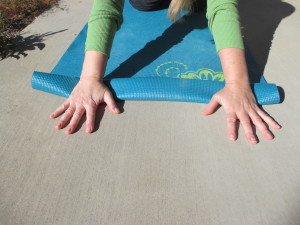
Fold the mat as indicated, and place the heel of your hand on the rolled up mat, allowing the wrist joint to experience less flexion.
Wall Dog AKA, Shouldn’t or Can’t practice with hands on the floor
The benefits of strengthening arms, extending the spine and stretching the backs of the legs can still be found in this variation. If the following apply to you: difficulty bearing weight on the wrists or arms, pregnancy (for some), challenged getting up and down off the floor, or if you are simply at work, escort your dog to the wall!
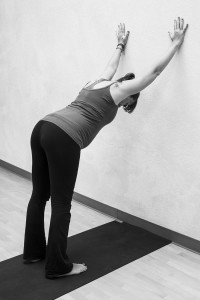
Chair Dog/ Working-in-the-office dog
This is another great variation for those who have been sitting and working for hours, or students who have difficulty getting up and down off the floor. Another example of poses I teach in some chair yoga classes.
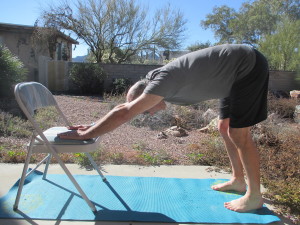
Prenatal dog
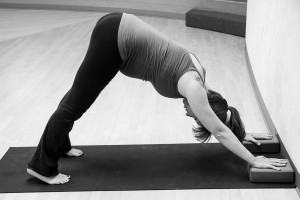
For prenatal yoga students in their first or second trimesters, who have had a regular practice of downdog before and throughout their pregnancy, I will sometimes offer this variation depending on how their particular pregnancy is progressing.
3 legged dog or Downdog at the fire hydrant
Once your arm strength has improved, this is a fun variation that engages your core muscles more.
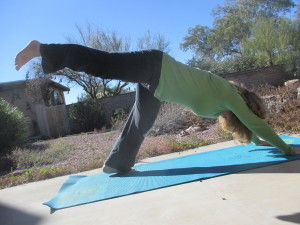
There are many other ways to vary downward facing dog so the pose works for you. Looking forward to seeing you in class and/or hearing from you!

5 Comments
Thank you!! Let me know how it goes!
I am not pregnant, but due to my very tight hamstrings, often use the prenatal version.
I may “escort my dog to the wall” when I get back to office work.
Great article – thank you!
Comments are closed.